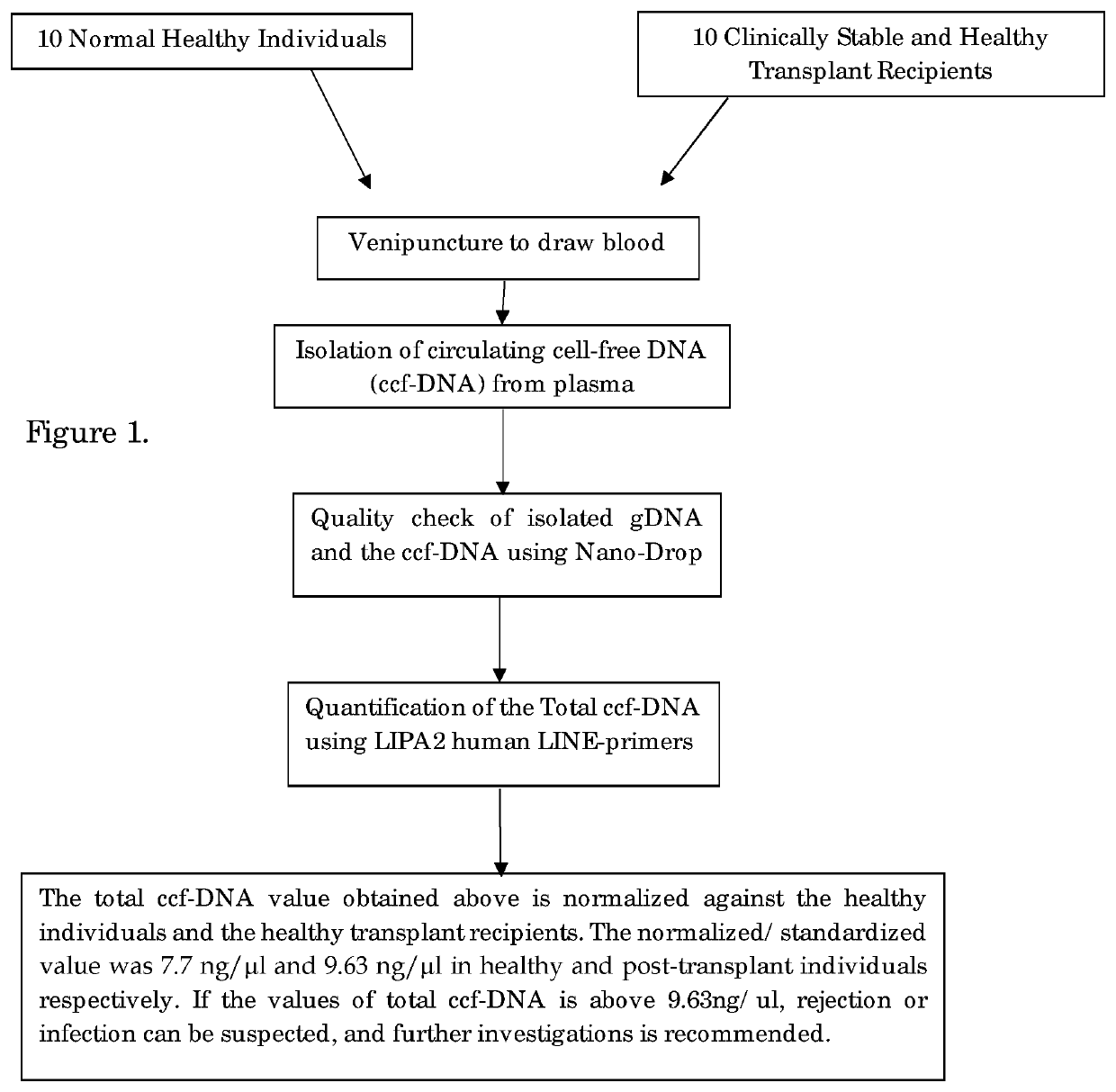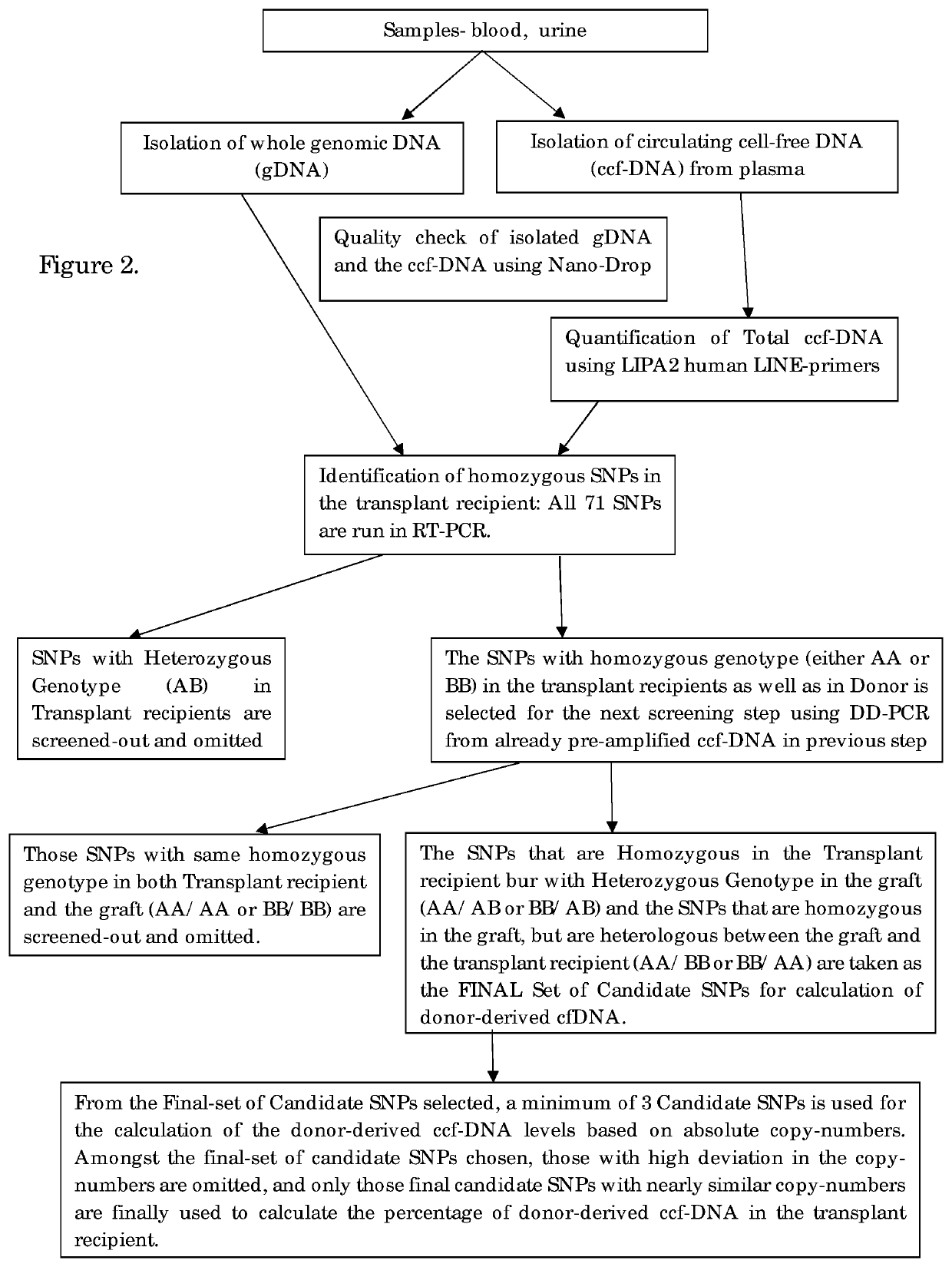Non-invasive method for monitoring transplanted organ status in organ-transplant recipients
a transplant recipient and non-invasive technology, applied in the field of medical diagnostics, can solve the problems of high cost of hospitalization, difficult frequent monitoring of transplanted grafts, and significant medical risks
- Summary
- Abstract
- Description
- Claims
- Application Information
AI Technical Summary
Benefits of technology
Problems solved by technology
Method used
Image
Examples
example 1
[0037]STEP-1: Sample Collection and Separation of Plasma
[0038]5 ml of peripheral blood was collected by venipuncture into an EDTA-coated collection tube both from the donor and the recipient.
[0039]Urine samples were prepared by allowing it to stand until all the debris is settled and the clear upper layer is taken for analysis.
[0040]From this, 2 ml of blood was centrifuged at 5000 rpm for 10 min and plasma was carefully removed from the top and stored at −20° C. for further use.
[0041]STEP-2: Isolation of Circulating Cell-Free DNA, Genomic DNA:
[0042]2(a) Isolation of Circulating Cell-Free DNA (ccfDNA):
[0043]The circulating cell-free DNA (ccfDNA) is isolated from plasma following the manufacturer's instructions of EpiQuik Circulating cell-free DNA Isolation kit, Epigentek Group Inc. USA. The ccfDNA was isolated by adding 0.5 ml of plasma with 24 μl of ccfDNA capture Enhancer; 900 μl of Capture Buffer and 50 μl ccfDNA Capture Beads into 1.7 ml micro centrifuge tube. The solution was mi...
example 2
[0049]PCR Amplification and Determination of Total ccfDNA Value:
[0050]Total ccfDNA was quantified using multi locus LIPA2 regions. LIPA2 is a human Long Interspersed Element (LINE) of the class L1, that is well interspersed throughout the human genome. Reaction mixture for each LIPA-qPCR (90 bp and 222 bp amplicons) contained 3 μl DNA template, 0.5 μl of the each forward and reverse primer, 0.4 μl Rox as passive reference dye, 10 μl SYBR Green Master Mix (KAPA) and made up to total reaction volume of 20 μl with 95° C. for 1 min, followed by 40 cycles of 95° C. for 15 s. and annealing at 64° C. for 1 min in Stepone plus Real-Time PCR. System (Applied Biosystems, USA).
[0051]LIPA-qPCR reactions were standardized using 10 healthy control samples to yield the total ccfDNA results. The “control-value” is an average of total ccfDNA value of the ccfDNA levels of 10 healthy control and used as the standard. “Control Value” of the total ccfDNA of healthy subject is <7.7 ng / μl. The total ccfDN...
example 3
[0053]PCR Amplification and Determination of the Donor-Derived ccfDNA.
[0054]The donor derived ccfDNA amplification is performed by DDPCR for the identification of the organ transplant status in the transplant recipient. Firstly, screening of all the High-MAF SNPs was done in both genomic DNA as well as the circulating cell-free DNA using Real-Time PCR. In this step, the SNPs that have heterozygous genotype in the recipient are filtered out and eliminated, since they cannot be used for quantification in DDPCR. In the next step, the pre-amplified ccfDNA is used as the template, and the candidate SNPs are filtered out and the assay is set for the individual patient. The SNPs which are homozygous in the recipient and that could be either heterozygous or homozygous on the allele in the graft and is preferably heterologous between the recipient and the graft is chosen as the final candidate SNPs. This step is performed as a DDPCR assay.
[0055]All homozygous SNPs were subsequently used to g...
PUM
| Property | Measurement | Unit |
|---|---|---|
| volume | aaaaa | aaaaa |
| volume | aaaaa | aaaaa |
| volume | aaaaa | aaaaa |
Abstract
Description
Claims
Application Information
 Login to View More
Login to View More - R&D
- Intellectual Property
- Life Sciences
- Materials
- Tech Scout
- Unparalleled Data Quality
- Higher Quality Content
- 60% Fewer Hallucinations
Browse by: Latest US Patents, China's latest patents, Technical Efficacy Thesaurus, Application Domain, Technology Topic, Popular Technical Reports.
© 2025 PatSnap. All rights reserved.Legal|Privacy policy|Modern Slavery Act Transparency Statement|Sitemap|About US| Contact US: help@patsnap.com


